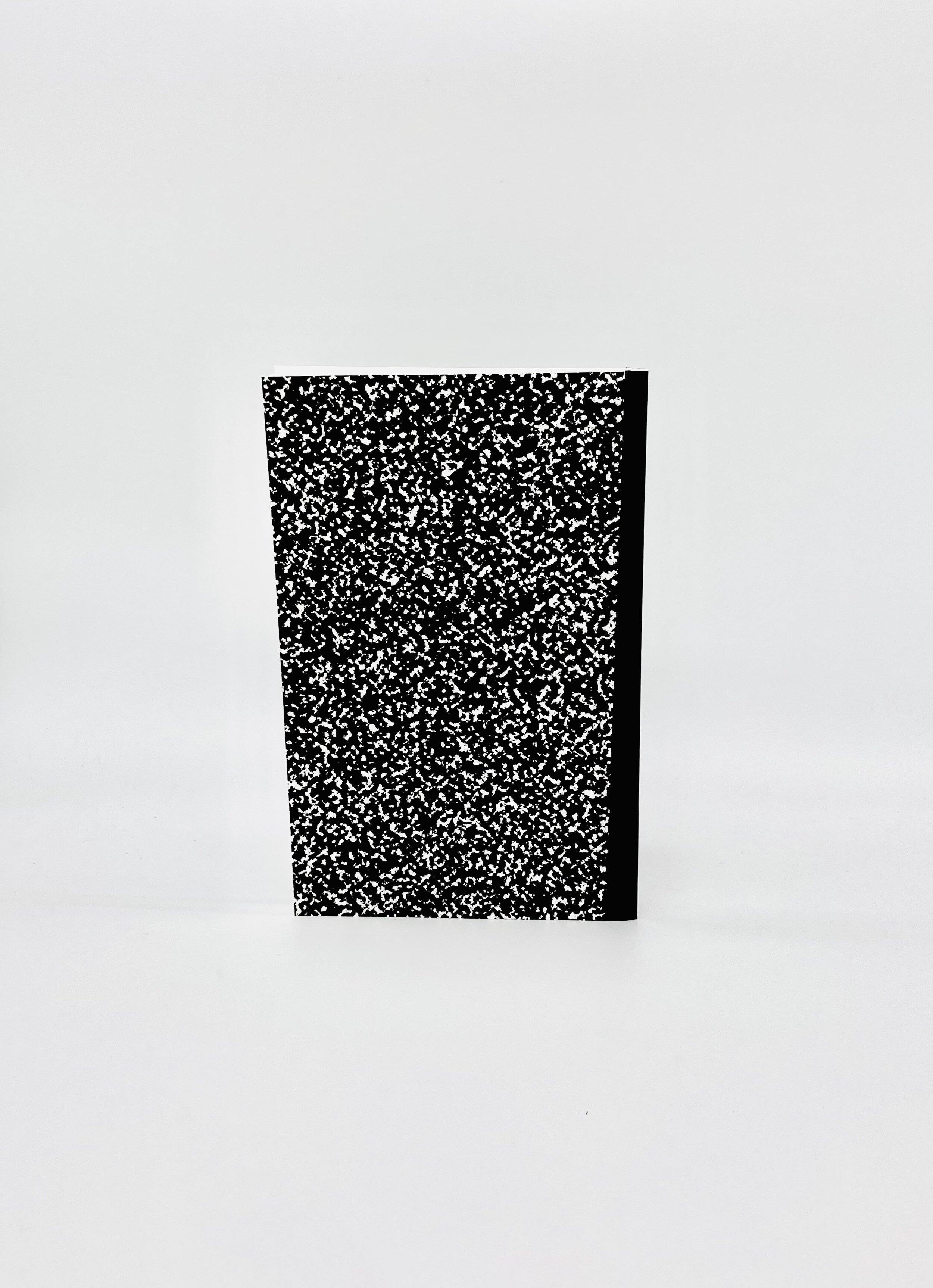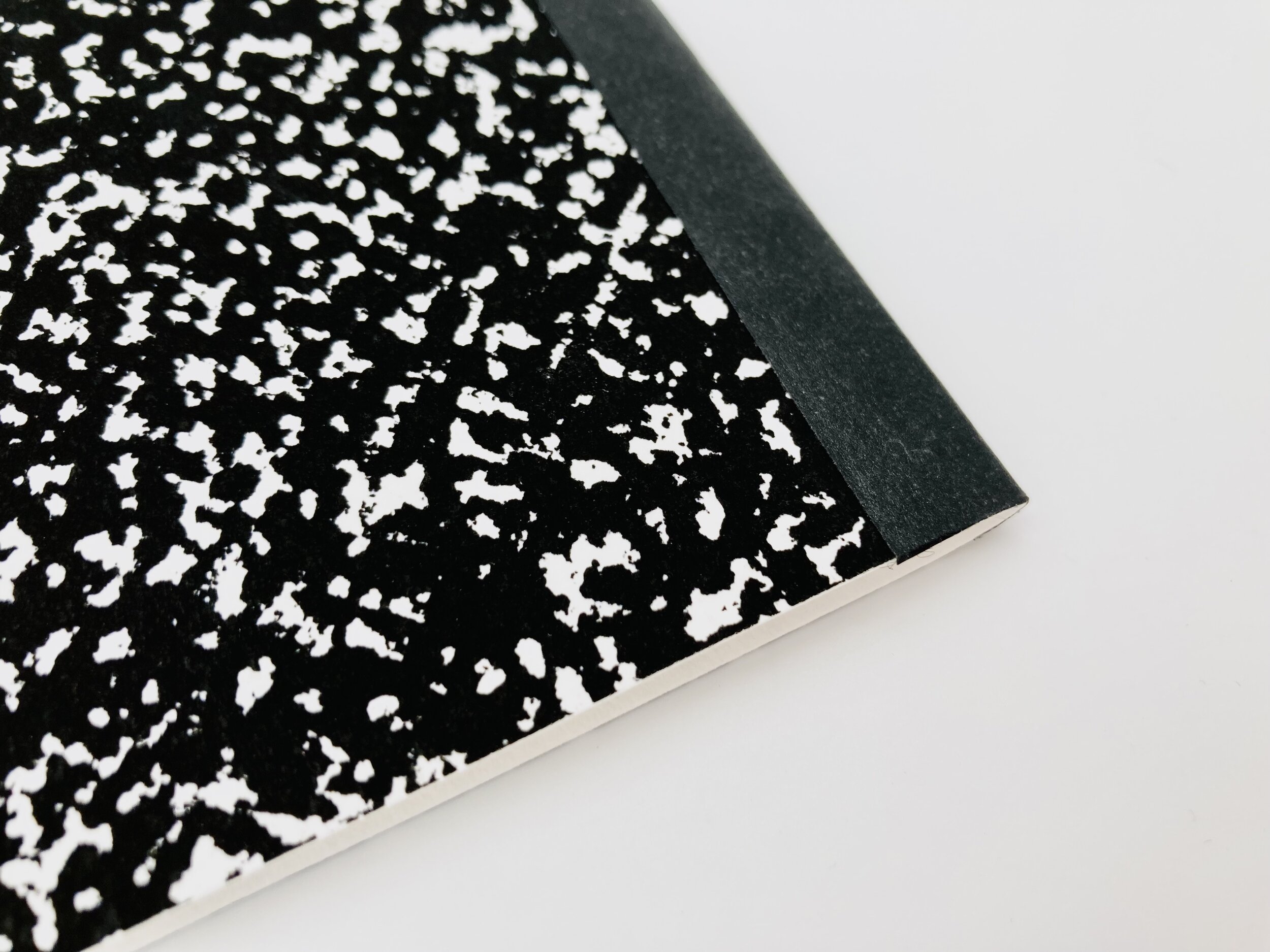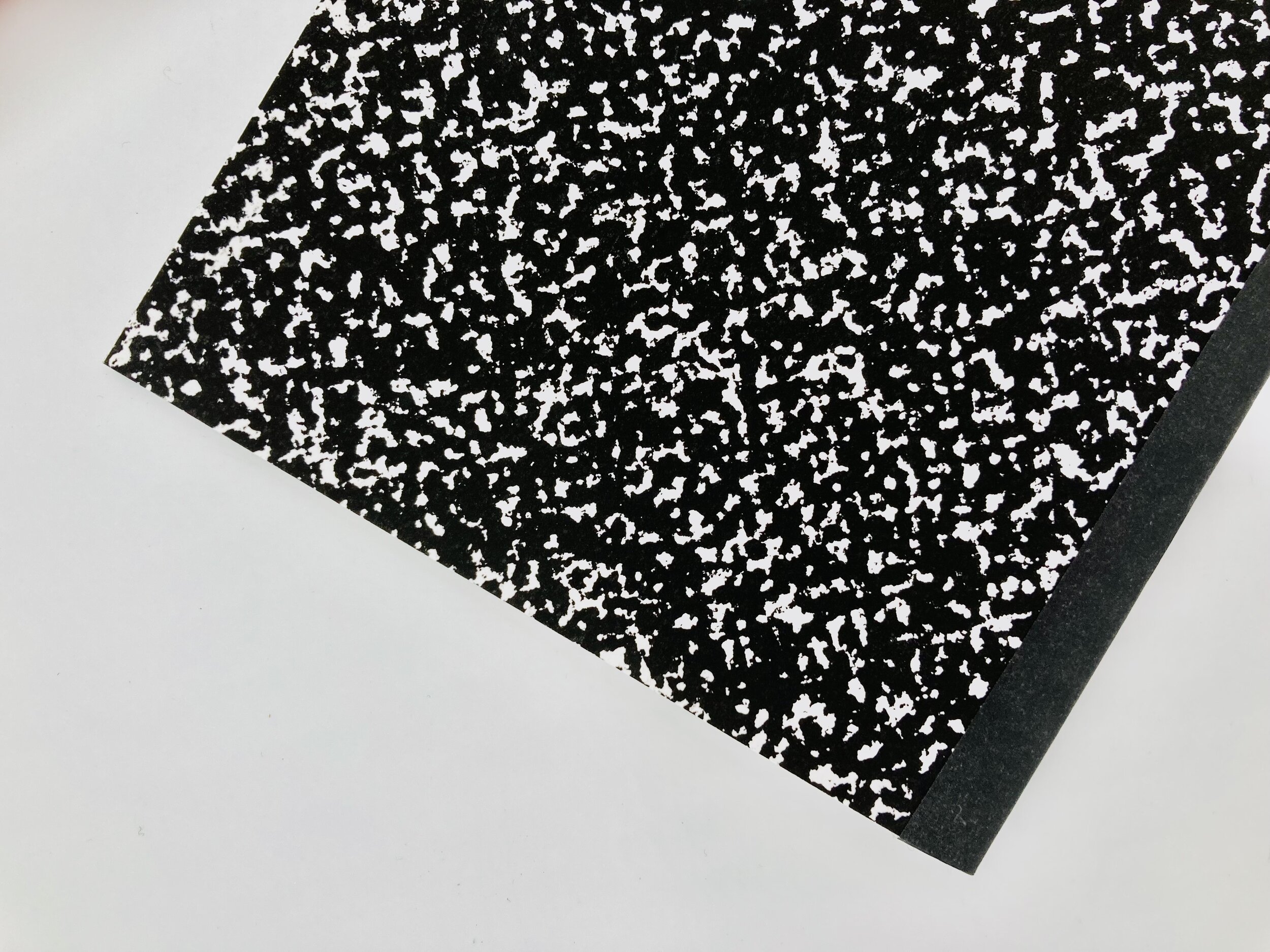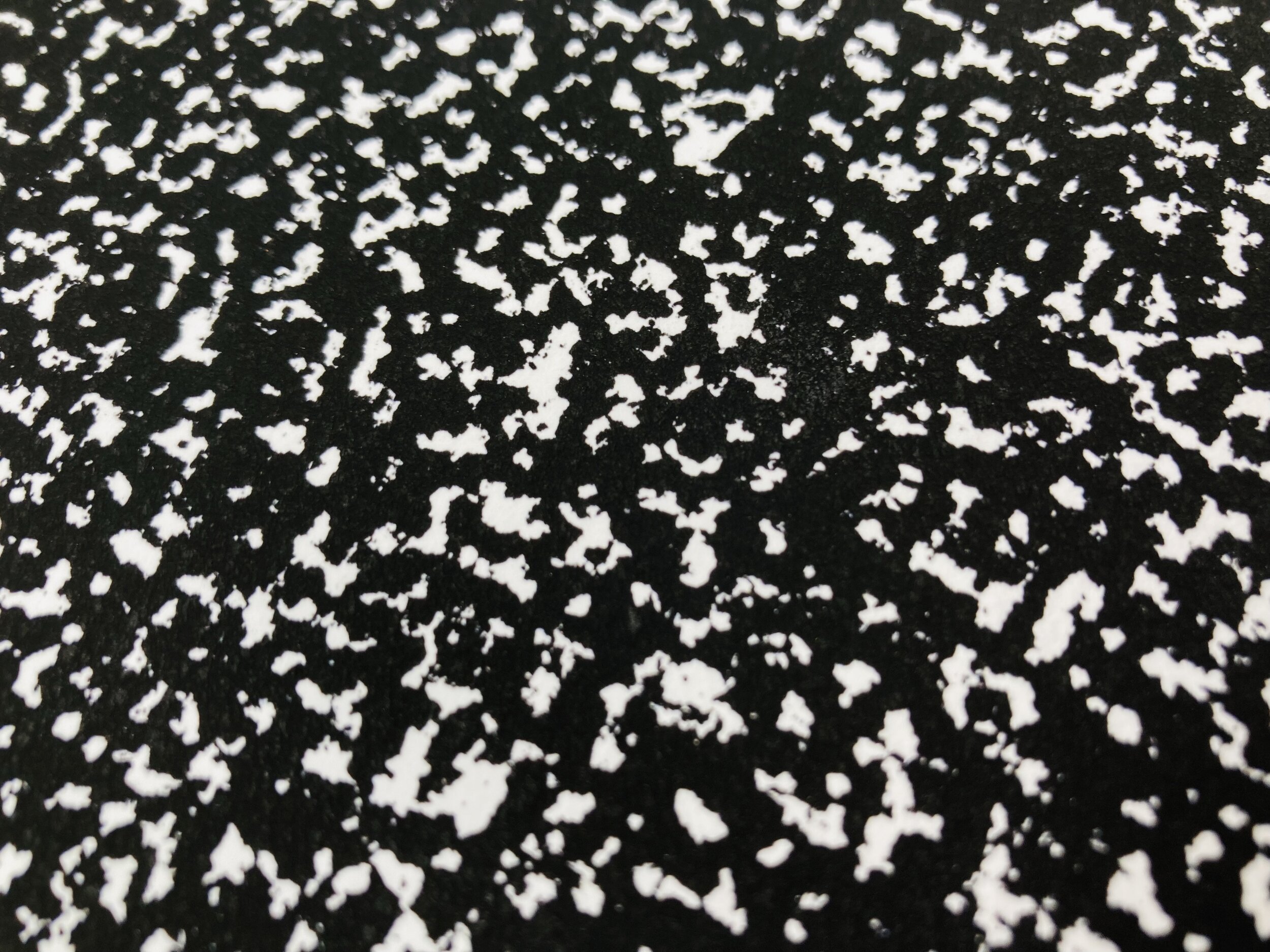Non-Words (2017) | Daniel Temkin
[New York]: self-published, [2017]. Handmade softcover booklet in textured cotton rag covers that are inkjet-printed in the style of a marbled composition notebook. Saddle-stitched and bound in black artist’s tape. Contents inkjet-printed in black and white. 22 x 14cm. [16] pages. Edition of 100 signed and numbered copies, each of which features 45 unique non-words not included in any other copy. As new, sold on behalf of the author.
In March 2015, a twitter bot called every non-word (@nondenotative) began emitting a series of curious neologisms—golfmis, hookhawk, pompousstub, tramwit, pilpred, conresectabil—in an attempt to “exhaust all possibilities of non-existent English words.” Behind this inversion of Allison Parrish’s everyword, a bot that tweeted the English lexicon over the course of seven years, is the New York–based artist Daniel Temkin.
Temkin’s procedure for generating non-words relies on a database of English words, which he subjects to hyphenation scripts that identify the syllables composing each word. Next, Temkin recombines these syllables into new words, using a probabilistic method that prefers syllable collocations that are attested in the English lexicon. Upon generating a candidate non-word, a final check ensures that the word does not appear in the database of actual English words.
In 2017, at which point every non-word had tweeted out 36,000 examples, Temkin produced an edition of 100 handmade zines, each containing a unique set of 45 non-words produced by the algorithm outlined above. As such, this is one of the few physical books to appear in an edition of unique copies—a lineage that traces back to A House of Dust (ca. 1968) by Alison Knowles, James Tenney, and Siemens System 4004.
The striking Non-Words zines are wrapped in textured cotton rag paper, inkjet-printed with a classic marbled pattern, and staple-bound under black artist’s tape. The typesetting presents each non-word as a dictionary entry whose definition may be filled in by the reader. In turn, these entries are delineated by dotted lines, inviting one to cut them out—perhaps for ease of reference, on the go. Each unique copy of Non-Words is signed and numbered in pen.
Aleator Press is thrilled to offer remaining stock from the limited print run of this exquisitely handmade computer-generated book. We are distributing these on behalf of Daniel Temkin, who will receive the full proceeds on all sales.
[New York]: self-published, [2017]. Handmade softcover booklet in textured cotton rag covers that are inkjet-printed in the style of a marbled composition notebook. Saddle-stitched and bound in black artist’s tape. Contents inkjet-printed in black and white. 22 x 14cm. [16] pages. Edition of 100 signed and numbered copies, each of which features 45 unique non-words not included in any other copy. As new, sold on behalf of the author.
In March 2015, a twitter bot called every non-word (@nondenotative) began emitting a series of curious neologisms—golfmis, hookhawk, pompousstub, tramwit, pilpred, conresectabil—in an attempt to “exhaust all possibilities of non-existent English words.” Behind this inversion of Allison Parrish’s everyword, a bot that tweeted the English lexicon over the course of seven years, is the New York–based artist Daniel Temkin.
Temkin’s procedure for generating non-words relies on a database of English words, which he subjects to hyphenation scripts that identify the syllables composing each word. Next, Temkin recombines these syllables into new words, using a probabilistic method that prefers syllable collocations that are attested in the English lexicon. Upon generating a candidate non-word, a final check ensures that the word does not appear in the database of actual English words.
In 2017, at which point every non-word had tweeted out 36,000 examples, Temkin produced an edition of 100 handmade zines, each containing a unique set of 45 non-words produced by the algorithm outlined above. As such, this is one of the few physical books to appear in an edition of unique copies—a lineage that traces back to A House of Dust (ca. 1968) by Alison Knowles, James Tenney, and Siemens System 4004.
The striking Non-Words zines are wrapped in textured cotton rag paper, inkjet-printed with a classic marbled pattern, and staple-bound under black artist’s tape. The typesetting presents each non-word as a dictionary entry whose definition may be filled in by the reader. In turn, these entries are delineated by dotted lines, inviting one to cut them out—perhaps for ease of reference, on the go. Each unique copy of Non-Words is signed and numbered in pen.
Aleator Press is thrilled to offer remaining stock from the limited print run of this exquisitely handmade computer-generated book. We are distributing these on behalf of Daniel Temkin, who will receive the full proceeds on all sales.
[New York]: self-published, [2017]. Handmade softcover booklet in textured cotton rag covers that are inkjet-printed in the style of a marbled composition notebook. Saddle-stitched and bound in black artist’s tape. Contents inkjet-printed in black and white. 22 x 14cm. [16] pages. Edition of 100 signed and numbered copies, each of which features 45 unique non-words not included in any other copy. As new, sold on behalf of the author.
In March 2015, a twitter bot called every non-word (@nondenotative) began emitting a series of curious neologisms—golfmis, hookhawk, pompousstub, tramwit, pilpred, conresectabil—in an attempt to “exhaust all possibilities of non-existent English words.” Behind this inversion of Allison Parrish’s everyword, a bot that tweeted the English lexicon over the course of seven years, is the New York–based artist Daniel Temkin.
Temkin’s procedure for generating non-words relies on a database of English words, which he subjects to hyphenation scripts that identify the syllables composing each word. Next, Temkin recombines these syllables into new words, using a probabilistic method that prefers syllable collocations that are attested in the English lexicon. Upon generating a candidate non-word, a final check ensures that the word does not appear in the database of actual English words.
In 2017, at which point every non-word had tweeted out 36,000 examples, Temkin produced an edition of 100 handmade zines, each containing a unique set of 45 non-words produced by the algorithm outlined above. As such, this is one of the few physical books to appear in an edition of unique copies—a lineage that traces back to A House of Dust (ca. 1968) by Alison Knowles, James Tenney, and Siemens System 4004.
The striking Non-Words zines are wrapped in textured cotton rag paper, inkjet-printed with a classic marbled pattern, and staple-bound under black artist’s tape. The typesetting presents each non-word as a dictionary entry whose definition may be filled in by the reader. In turn, these entries are delineated by dotted lines, inviting one to cut them out—perhaps for ease of reference, on the go. Each unique copy of Non-Words is signed and numbered in pen.
Aleator Press is thrilled to offer remaining stock from the limited print run of this exquisitely handmade computer-generated book. We are distributing these on behalf of Daniel Temkin, who will receive the full proceeds on all sales.










